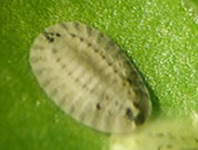Abstract
A new species of myrmecophilous lady beetle, Diomus lupusapudoves, sp. nov. (Coleoptera: Coccinellidae: Diomini), is described from a coffee agroecosystem in Chiapas, Mexico. The new species was found preying on the green coffee scale pest, Coccus viridis (Green), tended primarily by Azteca sericeasur Longino and Pheidole synanthropica Longino ants. The larval, pupal, and adult stages of the new species are described and habitus illustrations or photos provided along with anatomical details of the adult male and female genitalia. The species is most similar to Diomus thoracicus Fabricius (=type species of Diomus), another myrmecophile, which inhabits ant nests and feeds on ant brood. The new species has a peculiar onisciform larva that lacks dorsal setae, features that it shares with D. thoracicus. The new species is only the second species in the genus reported as a myrmecophile, although the life histories of most species have been poorly documented.
References
Dixon, A. (2000) Insect Predator-Prey Dynamics: Ladybird Beetles and Biological Control. Cambridge University Press, Cambridge, 268 pp.
García Morales, M., Denno, B., Miller, D., Miller, G., Ben-Dov, Y. & Hardy, N. (2016) ScaleNet: A literature-based model of scale insect biology and systematics. Available from: http://scalenet.info (accessed 10 October 2017)
Gill, R.J., Nakahara, S. & Williams, M. (1977) A review of the genus Coccus Linnaeus in America north of Panama (Homoptera: Coccoidea: Coccidae). Occasional Papers in Entomology, State of California, Department of Food and Agriculture, 24, 1–44.
Gordon, R. (1999) South American Coccinellidae (Coleoptera), Part VI: A systematic revision of the South American Diomini, new tribe (Scymninae). Annales Zoologici, Warsaw, 49, 1–219.
Gordon, R.D. (1976) The Scymnini of the United States and Canada: Key to genera and revision of Scymnus, Nephus and Diomus. Bulletin of the Buffalo Society of Natural Sciences, 28, 1–362.
Hanks, L.M. & Sadof, C.S. (1990) The effect of ants on nymphal survivorship of Coccus viridis (Homoptera: Coccidae). Biotropica, 22, 210–213.
https://doi.org/10.2307/2388415Hodek, I., van Emden, H.F. & Honek, A. (Eds.) (2012) Ecology and Behavior of the Ladybird Beetles. John Wiley & Sons, Ltd, Oxford, 600 pp.
Iverson, A.L. (2015) Biological Control, Biodiversity, and Multifunctionality in Coffee Agroecosystems. Unpublished Ph.D. dissertation, University of Michigan, Michigan, 183 pp.
Iverson, A., Jackson, D., Burnham, R., Perfecto, I., Vandenberg, N. & Vandermeer, J. (2018) Species complementarity in two myrmecophilous lady beetle species in a coffee agroecosystem: Implications for biological control. BioControl, 63 (2), 253–264.
https://doi.org/10.1007/s10526-017-9865-1Liere, H., Jackson, D. & Vandermeer, J. (2012) Ecological complexity in a coffee agroecosystem: Spatial heterogeneity, population persistence and biological control. PLoS ONE, 7, 1–9.
https://doi.org/10.1371/journal.pone.0045508Majerus, M.E., Sloggett, J.J., Godeau, J.F. & Hemptinne, J.L. (2007) Interactions between ants and aphidophagous and coccidophagous ladybirds. Population Ecology, 49, 15–27.
https://doi.org/10.1007/s10144-006-0021-5Merrill, G. (1953) Scale insects of Florida. State Plant Board of Florida Bulletin, 1, 93–94.
Miller, D.R., Miller, G.L., Hodges, G.S. & Davidson, J.A. (2005) Introduced scale insects (Hemiptera: Coccoidea) of the United States and their impact on U.S. agriculture. Proceedings of the Entomological Society of Washington, 107, 123–158.
https://doi.org/10.1017/CBO9781107415324.004Pang, H. & Ślipiński, A. (2009) Revision of the Australian Coccinellidae (Coleoptera). Genus Diomus Mulsant. Part 1. Annales Zoologici, 59, 641–698.
https://doi.org/10.3161/000345409x485008Pang, H. & Ślipiński, A. (2010) Revision of the Australian Coccinellidae (Coleoptera). Genus Diomus Mulsant. Part 2. Annales Zoologici, 60, 493–545.
https://doi.org/10.3161/000345410X550382Pang, X.F. & Gordon, R.D. (1986) The Scymnini (Coleoptera: Coccinellidae) of China. The Coleopterists Bulletin, 40, 157–199.
Peck, S.B. (2015) The beetles of the Lesser Antilles (Insecta, Coleoptera): diversity and distributions. Insecta Mundi, 0460, 1–360.
Roux, O., Vantaux, A., Petitclerc, F., Orivel, J., Dejean, A. & Billen, J. (2017) Structural adaptations and mechanism of reflex bleeding in the larvae of the myrmecophilous ladybird Diomus thoracicus. Arthropod Structure & Development, 46 (4), 529–536.
https: //doi.org/10.1016/j.asd.2017.06.002Ślipiński, A. (2007) Australian Ladybird Beetles (Coleoptera: Coccinellidae): Their Biology and Classification. Australian Biological Resources Study, Canberra, ACT, 288 pp.
Sloggett, J.J., Wood, R.A. & Majerus, M.E.N. (1998) Adaptations of Coccinella magnifica Redtenbacher, a myrmecophilous coccinellid, to aggression by wood ants (Formica rufa group). I. Adult behavioral adaptation, its ecological context and evolution. Journal of Insect Behavior, 11, 889–904.
https://doi.org/10.1023/A:1020820428820Stehr, F. (Ed.) (1991) Immature Insects. Vol. 2. Kendall/Hunt, Dubuque, Iowa, xiv + 975 pp.
Styrsky, J.D. & Eubanks, M.D. (2007) Ecological consequences of interactions between ants and honeydew-producing insects. Proceedings of The Royal Society B Biological Sciences, 274, 151–164.
https://doi.org/10.1098/rspb.2006.3701Vandenberg, N.J. (2002) Coccinellidae Latreille, 1807. In: Arnett, R. & Thomas, M. (Eds.), American Beetles. Vol. 2. Polyphaga: Scarabaeoidea through Curculionoidea. CRC Press, Boca Raton, FL, pp. 371–389.
Vandenberg, N.J. & Hanson, P.E. (2018) Overview of the lady beetle tribe Diomini (Coleoptera; Coccinellidae) and description of a new phytophagous, silk-spinning genus from Costa Rica that induces food bodies on leaves of Piper (Piperaceae). Zootaxa. [in review]
Vantaux, A., Roux, O., Magro, A., Ghomsi, N.T., Gordon, R.D., Dejean, A. & Orivel, J. (2010) Host-specific myrmecophily and myrmecophagy in the tropical coccinellid Diomus thoracicus in French Guiana. Biotropica, 42, 622–629.
https://doi.org/10.1111/j.1744-7429.2009.00614.xVantaux, A., Roux, O., Magro, A., & Orivel, J. (2012) Evolutionary Perspectives on Myrmecophily in Ladybirds. Psyche, Article ID 591570 (2012), 1–7.
https://doi.org/10.1155/2012/591570Völkl, W. (1995) Behavioral and morphological adaptations of the coccinellid, Platynaspis luteorubra for exploiting ant-attended resources (Coleoptera: Coccinellidae). Journal of Insect Behavior, 8, 653–670.
https://doi.org/10.1007/bf01997236Young, G.R. (1982) Recent work on biological control in Papua New Guinea and some suggestions for the future. Tropical Pest Management, 28, 107–114.
https://doi.org/10.1080/09670878209370686

